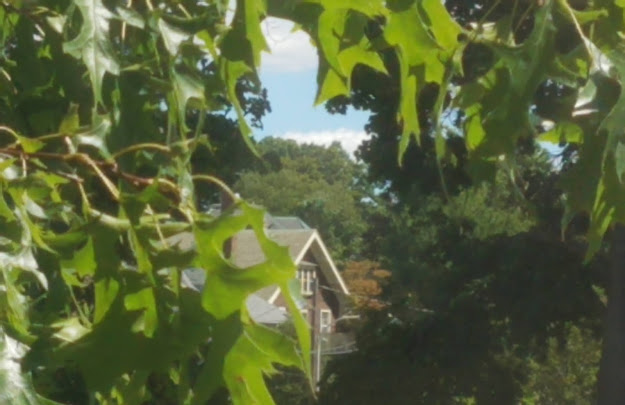(a) Arber, Germany
(b) Bergen, Norway
(c) Bernese Oberland, Switzerland
(d) Watertown, Massachusetts, USA
Stumped? I don't blame you. Looks can be deceiving when trees shroud enough environmental details to frame a building in a new context that obscures its original one, as if Photoshopping out the extraneous to capture the essence, or doing nature's duty to bring out beauty.
 |
| Photo by Cristo Vlahos. License: CC BY-SA 3.0. |
BTW, the answer is (d). The house pictured above is viewed from my bedroom window. The chalet at right is in fact in Bernese Oberland, showing how trees and other greenery create appealing scenery that brings out the chalet's woodsy character, complementing its honest expression of the origin of its building materials.
Here's another instance of tree-trim from my own experience. When I went up a steeply inclined avenue to look at a room for rent at its summit, I was stunned by the scene before me. It looked and felt as if I'd just stepped into the flatlands of Denmark, the way the avenue suddenly leveled out and the trees seemed to highlight the European aspects of the architecture through their international arboreal language.
This was the house, looking Scandinavian in its clean-lined simplicity, bolstered by backyard and street-lining trees that crispen its appearance by contrasting it with the heft of shade, as well as the complement of the archetypal white picket fence of suburban America.
Which gives it away that this is not in Denmark. It's at the crest of Summit Avenue in Brookline, Massachusetts, a block or so from Corey Hill Park. That hilltop oasis also testifies to the power of trees in space-shaping and sight-softening, without which the rocks, furniture, turf, paving and background buildings would seem as barren, hard and dry as a rocky desert or smoggy city (and the atmosphere would feel like either):
 |
| Photos by Maurene K., courtesy of TripAdvisor |
Here are examples of Denmark's benchmarks of tree-effect:
 |
| Photo by Okin. License: CC BY-SA 3.0 |
 |
| Image courtesy of Best-Wallpaper.net |
 |
| Photo by Dr. James Garner Williams (License: CC BY-SA 2.5) |
Between the buildings, elms curved so high that you ceased to remember their height until you looked above the familiar trunks and the lowest umbrellas of leaves and took in the lofty complex they held high above, branches and branches of branches, a world of branches with an infinity of leaves.
So, wherever under the blue sky you are—Arber, Bergen, Bernese Oberland, Watertown, or right in your own back yard—be sure to look between the buildings for that infinity of leaves without which any house, hall or high-rise would look like a son of the desert, rather than a child of nature.
Thank you for visiting. I welcome your comments!





















No comments:
Post a Comment